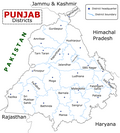| Bagri | |
|---|---|
| बागड़ी | |
 The word "Bagri" written in Devanagari script | |
| Native to | India |
| Region | Bagar |
| Ethnicity | Rajasthani |
Native speakers | 8,556,652 (2011 census) [1] |
| Devanagari, | |
| Official status | |
Recognised minority language in | |
| Language codes | |
| ISO 639-3 | bgq |
| Glottolog | bagr1243 |
Bagar Region | |
The Bagri language is a dialect of Rajasthani that takes its name from the Bagar tract region of Northwestern India in the states of Rajasthan, Punjab and Haryana. [3] Bagri is a typical Indo-Aryan language akin to Rajasthani and Haryanvi with SOV word order. The most striking phonological feature of Bagri is the presence of three lexical tones: high, mid, and low, akin to Rajasthani, Haryanvi, and Punjabi. Bagri is a language of earlier Bikaner state which included district Sri Ganganagar, Hanumangarh, Churu, Bikaner of Rajasthan and Sirsa (Haryana), Hisar (Haryana), Fazilka (Punjab) at a point in time.
Contents
- Geographical distribution
- Features
- Phonology
- Declension
- Verbs
- Syntax
- Samples
- Official status
- Work on Bagri
- Gallery
- See also
- References
- Bibliography
- External links
The speakers are mostly in India, with a minority of them in Bahawalpur and Bahawalnagar areas in modern day Pakistan, and with a majority speaker in rania,sirsa(haryana), in jaj colony. According to the 2011 census of India, there are 234,227 speakers of Bagri in Rajasthan and 1,656,588 speakers of Bagri in Punjab and Haryana. [4]





